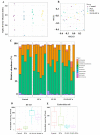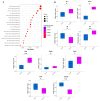Novel Probiotic Bacterium Rouxiella badensis subsp. acadiensis (Canan SV-53) Modulates Gut Immunity through Epigenetic Mechanisms
- PMID: 37894114
- PMCID: PMC10609533
- DOI: 10.3390/microorganisms11102456
Novel Probiotic Bacterium Rouxiella badensis subsp. acadiensis (Canan SV-53) Modulates Gut Immunity through Epigenetic Mechanisms
Abstract
Gut immune system homeostasis is crucial to overall host health. Immune disturbance at the gut level may lead to systemic and distant sites' immune dysfunction. Probiotics and prebiotics consumption have been shown to improve gut microbiota composition and function and enhance gut immunity. In the current study, the immunomodulatory and anti-inflammatory effects of viable and heat-inactivated forms of the novel probiotic bacterium Rouxiella badensis subsp. acadiensis (Canan SV-53), as well as the prebiotic protocatechuic acid (PCA) derived from the fermentation of blueberry juice by SV-53, were examined. To this end, female Balb/c mice received probiotic (viable or heat-inactivated), prebiotic, or a mixture of viable probiotic and prebiotic in drinking water for three weeks. To better decipher the immunomodulatory effects of biotics intake, gut microbiota, gut mucosal immunity, T helper-17 (Th17) cell-related cytokines, and epigenetic modulation of Th17 cells were studied. In mice receiving viable SV-53 and PCA, a significant increase was noted in serum IgA levels and the number of IgA-producing B cells in the ileum. A significant reduction was observed in the concentrations of proinflammatory cytokines, including interleukin (IL)-17A, IL-6, and IL-23, and expression of two proinflammatory miRNAs, miR-223 and miR425, in treated groups. In addition, heat-inactivated SV-53 exerted immunomodulatory properties by elevating the IgA concentration in the serum and reducing IL-6 and IL-23 levels in the ileum. DNA methylation analysis revealed the role of heat-inactivated SV-53 in the epigenetic regulation of genes related to Th17 and IL-17 production and function, including Il6, Il17rc, Il9, Il11, Akt1, Ikbkg, Sgk1, Cblb, and Smad4. Taken together, these findings may reflect the potential role of the novel probiotic bacterium SV-53 and prebiotic PCA in improving gut immunity and homeostasis. Further studies are required to ascertain the beneficial effects of this novel bacterium in the inflammatory state.
Keywords: DNA methylation; Th17 cell; gut immunity; gut microbiome; miRNA; prebiotic; probiotic SV-53.
Conflict of interest statement
The authors declare no conflict of interest. Where authors are identified as personnel of the International Agency for Research on Cancer/World Health Organization, the authors alone are responsible for the views expressed in this article and they do not necessarily represent the decisions, policies, or views of the International Agency for Research on Cancer/World Health Organization.
Figures






References
Grants and funding
LinkOut - more resources
Full Text Sources
Miscellaneous

